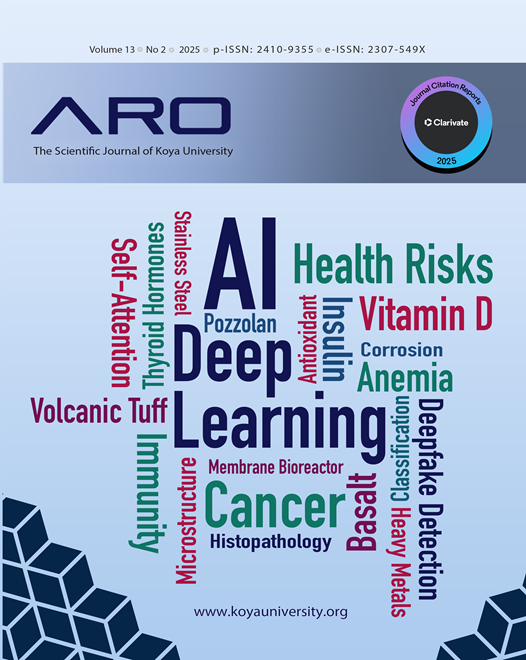Intelligent Transportation Systems for Deep Learning-Driven Vehicular Ad hoc Network
A Review
DOI:
https://doi.org/10.14500/aro.12054Keywords:
Artificial intelligence, Deep learning, Intelligent transportation systems, Network, Vehicular ad hoc networkAbstract
Abstract—Numerous studies demonstrate that the vehicular ad hoc network (VANET) depends on various characteristics and intermediate connections. It offers real-time automatic reaction and acute traffic analysis, but more studies are still needed to determine how best to use it in various situations. The primary goals of this VANET system are to distinguish between specific agents and identify collision remnants, which is still a research area in terms of scalability, optimization strategies, and efficient data aggregation. Due to problems with distance disintegration, temporal channel deterioration, and signal distortion, analysis was not feasible until recently. Therefore, this research will carry out a comparative review of available studies related to Intelligent Transportation Systems that use deep learning applications in VANETs, such as the recurrent neural network model, cybersecurity, decision-making, and collision avoidance, as well as future work, so it can have a more concise understanding of the topic.
Downloads
References
Alsarhan, A., Alauthman, M., Alshdaifat, E.A., Al-Ghuwairi, A.R., and Al-Dubai, A., 2023. Machine learning-driven optimization for SVM-based intrusion detection system in vehicular ad hoc networks. Journal of Ambient Intelligence and Humanized Computing, 14(5), pp.6113-6122. DOI: https://doi.org/10.1007/s12652-021-02963-x
Azzoug, Y., and Boukra, A., 2021. Bio-inspired VANET routing optimization: An overview: A taxonomy of notable VANET routing problems, overview, advancement state, and future perspective under the bio-inspired optimization approaches. Artificial Intelligence Review, 54, pp.1005-1062. DOI: https://doi.org/10.1007/s10462-020-09868-9
Babar, M., Tariq, M.U., Ullah, Z., Arif, F., Khan, Z., and Qureshi, B., 2025. An efficient and hybrid deep learning-driven model to enhance security and performance of healthcare internet of things. IEEE Access, 13, pp.22931-22945. DOI: https://doi.org/10.1109/ACCESS.2025.3536638
Bangui, H., and Buhnova, B., 2021. Recent advances in machine-learning driven intrusion detection in transportation: Survey. Procedia Computer Science, 184, pp.877-886. DOI: https://doi.org/10.1016/j.procs.2021.04.014
Chen, Y., Guo, J., Xu, H., Huang, J., and Su, L., 2023. Improved long short-term memory-based periodic traffic volume prediction method. IEEE Access, 11, pp.103502-103510. DOI: https://doi.org/10.1109/ACCESS.2023.3305398
Deo, N., and Trivedi, M.M. 2018. Convolutional social pooling for vehicle trajectory prediction. In: Proceedings of the IEEE Conference on Computer Vision and Pattern Recognition Workshops, pp.1468-1476. DOI: https://doi.org/10.1109/CVPRW.2018.00196
Fatima, E., Sumra, I.A., and Muzaffar, S.A., 2024. Enhancing vehicular network security: An in-depth analysis of machine learning approaches. Journal of Computing and Biomedical Informatics, 8(1), pp.784-801.
Fotros, M., Rezazadeh, J., and Ameri Sianaki, O., 2020. A survey on VANET routing protocols for IoT intelligent transportation systems. In Web, Artificial Intelligence and Network Applications: Proceedings of the Workshops of the 34th International Conference on Advanced Information Networking and Applications (WAINA-2020). Springer International Publishing, Switzerland, pp.1097-1115. DOI: https://doi.org/10.1007/978-3-030-44038-1_102
Ghani, M.U., Ahmad, A., and Mumtaz, G., 2024. AI-based network traffic analysis for threat hunting. Journal of Innovative Computing and Emerging Technologies, 4(2), pp.70-86. DOI: https://doi.org/10.56536/jicet.v4i2.158
Hiremath, S.C., and Mallapur, J.D., 2024. QoS based scheduling mechanism for electrical vehicles in cloud-assisted VANET using deep RNN. International Journal of System Assurance Engineering and Management, 15, pp.2571-2587. DOI: https://doi.org/10.1007/s13198-024-02277-z
Hossain, M.A., Noor, R.M., Yau, K.L.A., Azzuhri, S.R., Z’Aba, M.R., and Ahmed, I., 2020. A comprehensive survey of machine learning approaches in cognitive radio-based vehicular ad hoc networks. IEEE Access, 8, pp.78054-78108. DOI: https://doi.org/10.1109/ACCESS.2020.2989870
Huang, L., Ye, M., Xue, X., Wang, Y., Qiu, H., and Deng, X., 2024. Intelligent routing method based on dueling DQN reinforcement learning and network traffic state prediction in SDN. Wireless Networks, 30(5), pp.4507-4525. DOI: https://doi.org/10.1007/s11276-022-03066-x
Ivanenkov, Y., Zagribelnyy, B., Malyshev, A., Evteev, S., Terentiev, V., Kamya, P., Bezrukov, D., Aliper, A., Ren, F., and Zhavoronkov, A., 2023. The hitchhiker’s guide to deep learning driven generative chemistry. ACS Medicinal Chemistry Letters, 14(7), pp.901-915. DOI: https://doi.org/10.1021/acsmedchemlett.3c00041
Kaur, G., and Kakkar, D., 2022. Hybrid optimization enabled trust-based secure routing with deep learning-based attack detection in VANET. Ad Hoc Networks, 136, p.102961. DOI: https://doi.org/10.1016/j.adhoc.2022.102961
Kim, M.Y., and Cho, W., 2024. Development of a convlstm-based deep learning model for predicting typhoon intensity in climate change scenarios. Journal of the Korean Society of Marine Environment and Safety, 30(6), pp.541-551. DOI: https://doi.org/10.7837/kosomes.2024.30.6.541
Kwon, B.S., Park, R.J., and Song, K.B., 2020. Short-term load forecasting based on deep neural networks using LSTM layers. Journal of Electrical Engineering and Technology, 15, pp.1501-1509. DOI: https://doi.org/10.1007/s42835-020-00424-7
Lei, K., Guo, P., Zhao, W., Wang, Y., Qian, L., Meng, X., and Tang, L., 2022. Amulti-action deep reinforcement learning framework for the flexible job-shop scheduling problem. Expert Systems with Applications, 205, p.117796. DOI: https://doi.org/10.1016/j.eswa.2022.117796
Li, Y., Qian, B., Zhang, X., and Liu, H., 2020. Graph neural network-based diagnosis prediction. Big Data, 8(5), pp.379-390. DOI: https://doi.org/10.1089/big.2020.0070
Lin, X., Liu, A., Han, C., Liang, X., Wang, W., and Li, E., 2022. Deep learning‐based nonstationary channel prediction in tactical vehicle‐to‐vehicle communication environments. Wireless Communications and Mobile Computing, 2022(1), p.9121059. DOI: https://doi.org/10.1155/2022/9121059
Manderna, A., Kumar, S., Dohare, U., Aljaidi, M., Kaiwartya, O., and Lloret, J., 2023. Vehicular network intrusion detection using a cascaded deep learning approach with multi-variant metaheuristic. Sensors, 23(21), p.8772. DOI: https://doi.org/10.3390/s23218772
Marrogy, Q., and Ghassan, A., 2021. Improving VoIP transmission for IEEE 802.11n 5GHz MANET. Zanco Journal of Pure and Applied Sciences, 33(1), pp.157-162. DOI: https://doi.org/10.21271/ZJPAS.33.1.17
Mchergui, A., Moulahi, T., and Zeadally, S., 2022. Survey on artificial intelligence (AI) techniques for vehicular ad-hoc networks (VANETs). Vehicular Communications, 34, p.100403. DOI: https://doi.org/10.1016/j.vehcom.2021.100403
Mohammadi, M., Dideban, A., Lesani, A., and Moshiri, B., 2020. An implementation of the AI-based traffic flow prediction in the resilience control scheme. International Journal of Transportation Engineering, 8(2), pp.185-198.
Muktar, B., Fono, V., and Zongo, M., 2023. Predictive modeling of signal degradation in urban VANETs using artificial neural networks. Electronics, 12(18), p.3928. DOI: https://doi.org/10.3390/electronics12183928
Pethő, Z., 2023. The Safety Risk of Inter-Vehicular Communication Considering Network Performance and Vehicle Dynamics Factors. Doctoral Dissertation. Budapest University of Technology and Economics, Hungary.
Qasmarrogy, G., 2020. Optimizing video transmission performance in 5 GHz MANET. The Journal of the University of Duhok, 23(2), pp.402-411. DOI: https://doi.org/10.26682/csjuod.2020.23.2.33
QasMarrogy, G., 2021. Evaluation of flying ad hoc network topologies, mobility models, and IEEE standards for different video applications. Aro-the Scientific Journal of Koya University, 9(1), pp.77-88. DOI: https://doi.org/10.14500/aro.10764
QasMarrogy, G.A., and Fadhil, A.J., 2022. FANET drone’s data applications, mobility models and Wi-Fi IEEE 802.11n standards for real and non-real-time traffic. Cihan University-Erbil Scientific Journal, 6(2), pp.76-80. DOI: https://doi.org/10.24086/cuesj.v6n2y2022.pp76-80
Saoud, B., Shayea, I., Yahya, A.E., Shamsan, Z.A., Alhammadi, A., Alawad, M.A., and Alkhrijah, Y., 2024. Artificial intelligence, internet of things and 6G methodologies in the context of vehicular ad-hoc networks (VANETs): Survey. ICT Express, 10, pp.959-980. DOI: https://doi.org/10.1016/j.icte.2024.05.008
Setia, H., Chhabra, A., Singh, S.K., Kumar, S., Sharma, S., Arya, V., Gupta,B.B., and Wu, J., 2024. Securing the road ahead: Machine learning-driven DDoS attack detection in VANET cloud environments. Cyber Security and Applications, 2, pp.100037. DOI: https://doi.org/10.1016/j.csa.2024.100037
Shekhar, H., Bhushan Mahato, C., Suman, S.K., Singh, S., Bhagyalakshmi, L., Prasad Sharma, M., Laxmi Kantha, B., Agraharam, S.K., and Rajaram, A., 2023. Demand side control for energy saving in renewable energy resources using deep learning optimization. Electric Power Components and Systems, 51(19), pp.2397-2413. DOI: https://doi.org/10.1080/15325008.2023.2246463
Shen, X., Zhang, Y., Zhang, X., Raksincharoensak, P., and Hashimoto, K., 2023. Robust optimal braking policy for avoiding collision with front bicycle. IEEE Open Journal of Intelligent Transportation Systems, 4, pp.943-954. DOI: https://doi.org/10.1109/OJITS.2023.3335397
Shu, J., Zhou, L., Zhang, W., Du, X., and Guizani, M., 2020. Collaborative intrusion detection for VANETs: A deep learning-based distributed SDN approach. IEEE Transactions on Intelligent Transportation Systems, 22(7), pp.4519-4530. DOI: https://doi.org/10.1109/TITS.2020.3027390
Singh, S.K., Kumar, M., Tanwar, S., and Park, J.H., 2024. GRU-based digital twin framework for data allocation and storage in IoT-enabled smart home networks. Future Generation Computer Systems, 153, pp.391-402. DOI: https://doi.org/10.1016/j.future.2023.12.009
Srivastava, A., Prakash, A., and Tripathi, R., 2020. Location based routing protocols in VANET: Issues and existing solutions. Vehicular Communications, 23, p.100231. DOI: https://doi.org/10.1016/j.vehcom.2020.100231
Ul Hassan, M., Al-Awady, A.A., Ali, A., Sifatullah, Akram, M., Iqbal, M.M., Khan, J., and Abdelrahman Ali, Y.A., 2024. ANN-based intelligent secure routing protocol in vehicular ad hoc networks (VANETs) using enhanced AODV. Sensors (Basel), 24(3), p.818. DOI: https://doi.org/10.3390/s24030818
Wang, C., Luo, X., Ross, K., and Li, D., 2022. Vrl3: Adata-driven framework for visual deep reinforcement learning. Advances in Neural Information Processing Systems, 35, pp.32974-32988.
Wang, K., Ma, C., Qiao, Y., Lu, X., Hao, W., and Dong, S., 2021. A hybrid deep learning model with 1DCNN-LSTM-Attention networks for short-term traffic flow prediction. Physical A: Statistical Mechanics and its Applications, 583, p.126293. DOI: https://doi.org/10.1016/j.physa.2021.126293
Xie, Y., Zhuang, X., Xi, Z., and Chen, H., 2021. Dual-channel and bidirectional neural network for hypersonic glide vehicle trajectory prediction. IEEE Access, 9, pp.92913-92924. DOI: https://doi.org/10.1109/ACCESS.2021.3092515
Zhang, Y., Ye, T., Xi, H., Juhas, M., and Li, J., 2021. Deep learning driven drug discovery: Tackling severe acute respiratory syndrome coronavirus 2. Frontiers in Microbiology, 12, p.739684. DOI: https://doi.org/10.3389/fmicb.2021.739684
Zhang, T., Qiu, H., Mellia, M., Li, Y., Li, H. and Xu, K., 2022. Interpreting AI for networking: Where we are and where we are going. IEEE Communications Magazine, 60(2), pp.25-31. DOI: https://doi.org/10.1109/MCOM.001.2100736
Zhao, Z.Q., Zheng, P., Xu, S.T., and Wu, X., 2019. Object detection with deep learning: A review. IEEE Transactions on Neural Networks and Learning Systems, 30(11), pp.3212-3232. DOI: https://doi.org/10.1109/TNNLS.2018.2876865
Downloads
Published
How to Cite
Issue
Section
License
Copyright (c) 2025 Ghassan A. QasMarrogy

This work is licensed under a Creative Commons Attribution-NonCommercial-ShareAlike 4.0 International License.
Authors who choose to publish their work with Aro agree to the following terms:
-
Authors retain the copyright to their work and grant the journal the right of first publication. The work is simultaneously licensed under a Creative Commons Attribution License [CC BY-NC-SA 4.0]. This license allows others to share the work with an acknowledgement of the work's authorship and initial publication in this journal.
-
Authors have the freedom to enter into separate agreements for the non-exclusive distribution of the journal's published version of the work. This includes options such as posting it to an institutional repository or publishing it in a book, as long as proper acknowledgement is given to its initial publication in this journal.
-
Authors are encouraged to share and post their work online, including in institutional repositories or on their personal websites, both prior to and during the submission process. This practice can lead to productive exchanges and increase the visibility and citation of the published work.
By agreeing to these terms, authors acknowledge the importance of open access and the benefits it brings to the scholarly community.
Accepted 2025-06-23
Published 2025-07-27
















 ARO Journal is a scientific, peer-reviewed, periodical, and diamond OAJ that has no APC or ASC.
ARO Journal is a scientific, peer-reviewed, periodical, and diamond OAJ that has no APC or ASC.